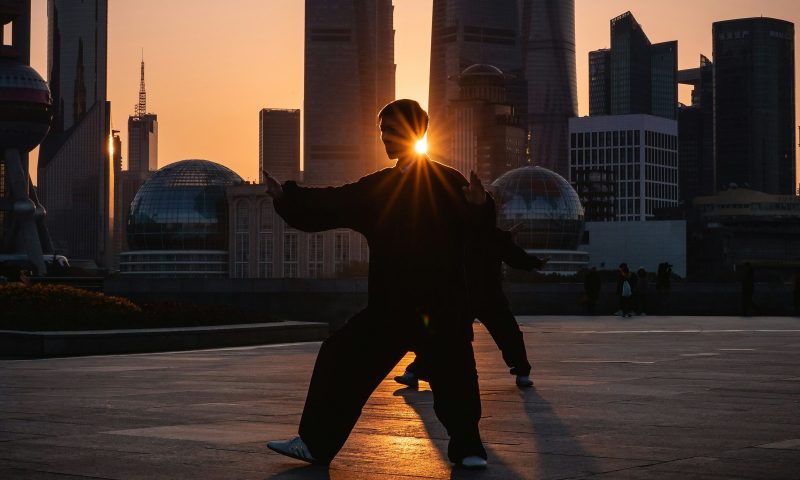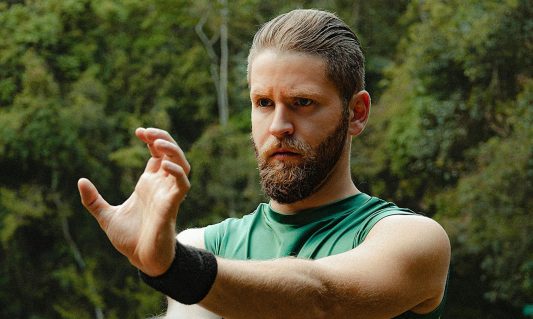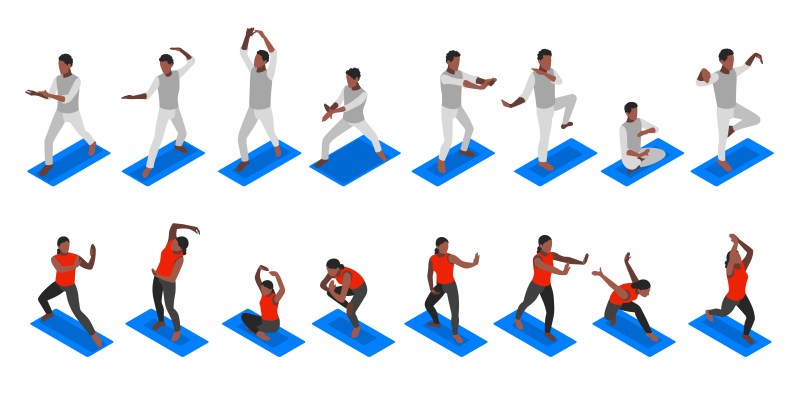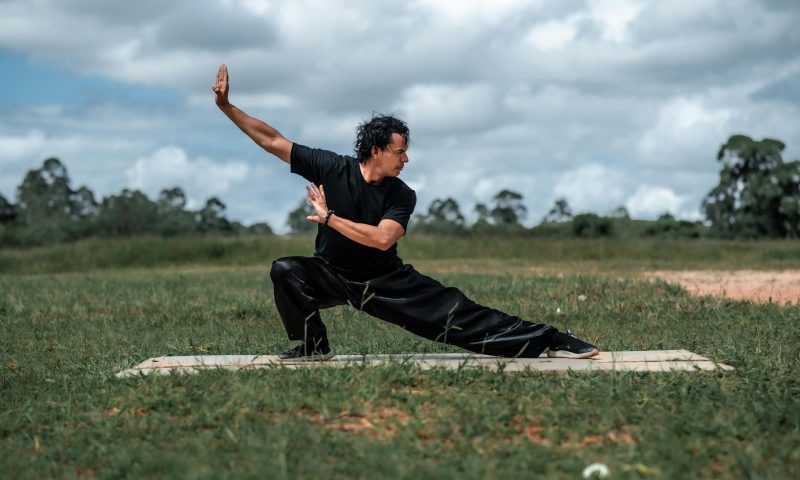With thousands of years of history, QiGong is an ancient Chinese meditation and movement technique that combines controlled breathing and gentle movements to promote physical, mental, and spiritual well-being. The rough translation of Qi is “vital life force,” and gong translates to “mastery” or “cultivation.” In traditional Chinese medicine, energy flows through the twelve meridians in the body, and health issues often stem from blocked energy. The idea is to use the healing practice of QiGong to help the energy, or qi, flow properly through your body.
I’ve always been especially interested in ancient Chinese medicine and alternative, holistic medicine because it helped me so much with my own healing journey dealing with an autoimmune bone condition called Ankylosing Spondylitis. While I have more experience with yoga than I do with QiGong, I personally know that the benefits of movement, meditation, and energy-centering can be pivotal.
I asked Master QiGong Instructor Lee Holden to share his experience with QiGong, including the benefits, his top tips, and how men can get started with this meditative movement practice. At Holden QiGong, he teaches online classes almost anywhere in the world. Holden is also an expert in meditation and Tai Chi, as well as a licensed acupuncturist, herbalist, and successful author.
QiGong Master Lee Holden

The Manual: How did you get started with QiGong?
Lee Holden: I first discovered QiGong after sustaining a back injury playing soccer. During a match, I jumped to head the ball, was knocked mid-air, and landed hard on my tailbone. The injury sidelined me for about a month before I remembered a childhood martial arts teacher of mine was also a healer. I returned home from college and started acupuncture and QiGong practices.
Remarkably, within just a week, I was back playing soccer, even though the team doctor had expected me to miss the entire season. Inspired by this rapid recovery, I began sharing QiGong exercises with my soccer teammates as a way to help them warm up and heal from injuries.

TM: Could you discuss the history of this ancient form of martial arts training?
LH: The history of QiGong is truly fascinating, dating back around 5,000 years. Early practitioners observed nature closely, mimicking its movements with their own bodies. By doing so, they discovered an inner power and a profound connection with life. The word “Qi” means “life-force energy,” and through these movements, practitioners harnessed and cultivated that energy.
QiGong evolved into a practice not just for physical wellness but also as a celebration of life, a healing modality, and a means of connecting deeply with one another and the world around them.

TM: What are the main physical benefits of QiGong?
LH: Historically known as “the art of preventing disease and prolonging life,” QiGong is rooted in Chinese medicine, where health practitioners were traditionally paid to maintain wellness rather than cure illness. If someone became ill, payments to the doctors stopped, underscoring the preventative nature of this practice. QiGong was an integral healing practice alongside acupuncture, herbs, nutrition, and massage — the five branches of traditional Chinese medicine.
Practiced daily, QiGong helps to maintain overall health, enhance vitality, and reduce chronic pain and tension by keeping energy balanced and flowing smoothly.

TM: What are the main mental health benefits of QiGong?
LH: QiGong is famously described as the practice of “less stress, more energy.” In Chinese medicine, emotional stress is considered a root cause of physical illness. QiGong practitioners aim to identify and clear underlying emotional imbalances that contribute to chronic conditions.
For example, recurring headaches might be traced to stress at work or home. By addressing these emotional roots, QiGong practitioners help individuals not only alleviate symptoms like headaches but also improve sleep, increase resilience, and reduce anxiety and depression. This holistic approach integrates mind, body, and emotions, promoting overall mental clarity and emotional wellness.

TM: How is QiGong different from Tai Chi?
LH: Great question! Tai Chi originated as a martial art and is essentially a form of QiGong adapted into flowing dance-like movements. Tai Chi sequences require memorizing specific movements and their martial arts applications, which makes it somewhat complex. In contrast, QiGong is simpler and more accessible, as it typically involves repeating individual movements designed to stretch and condition the body.
This repetition allows practitioners to focus deeply without the stress of memorizing complex routines, making QiGong ideal for beginners and those seeking immediate wellness benefits.

TM: How many times a week should our readers practice QiGong?
LH: While practicing QiGong daily provides the greatest benefits, even three to five sessions per week significantly enhances your energy and stress levels. Incorporating a brief morning routine energizes your day, while an evening practice helps clear stress, ensuring you don’t carry tension into your personal life.
TM: What’s the best time of day to practice QiGong?
LH: You can practice QiGong anytime it fits into your schedule. Traditionally, QiGong was practiced in the mornings to greet the day with more energy.

TM: How long is a typical practice, or does it vary?
LH: A typical QiGong practice ranges from as little as five minutes to up to an hour, depending on your schedule and goals. Even short daily sessions yield significant benefits. Ideally, a longer practice two or three times a week, complemented by shorter routines on other days, establishes greater balance and clarity in your energy.
TM: Could you explain to our readers the flow and fundamental concept of Qi in traditional Chinese medicine?
LH: In traditional Chinese medicine, “Qi” represents “life-force energy” — essentially the spark behind your vitality. It manifests uniquely throughout the body; for example: “Heart Qi” energizes the heart, “Lung Qi” fuels breathing, and “Digestive Qi” aids digestion. Emotional and mental well-being is also deeply tied to Qi.
Practicing Qi Gong optimizes the flow of Qi, improving overall health. Poor Qi circulation leads to stagnation, causing pain, illness, and fatigue. QiGong helps maintain a smooth flow, transforming stress and negative emotions into vitality and positivity.

TM: How does practicing QiGong activate and improve the flow of Qi?
LH: QiGong, literally meaning “working with life-force energy,” enhances the circulation of Qi throughout the body. Like water, Qi must flow freely, and stagnation causes health issues and discomfort. QiGong exercises promote movement and circulation, preventing stagnation and boosting overall health and vitality.
TM: Could you share your top beginner tips for our readers new to QiGong?
LH: My best tip for beginners is simply to give QiGong a try. Commit to practicing for just 10 minutes a day for one to two weeks, and you’ll notice a significant improvement in your energy levels and overall well-being. As you progress, aim for slightly longer sessions to maximize these benefits. Be warned, QiGong can quickly become an addicting part of your routine because of the positive impact it has on your life.




